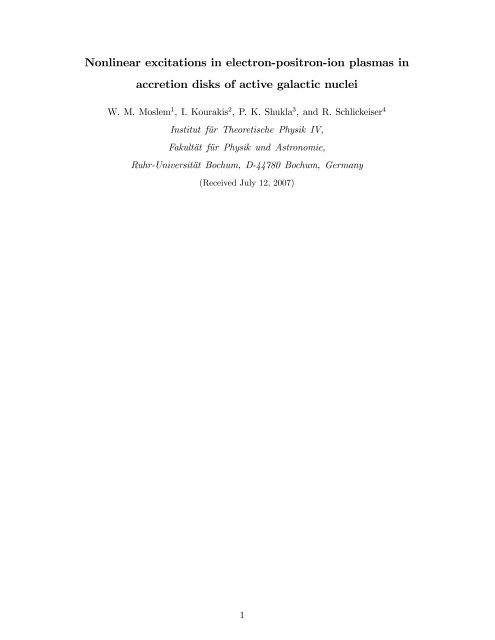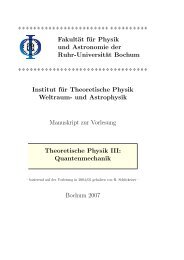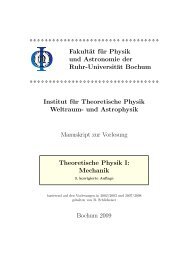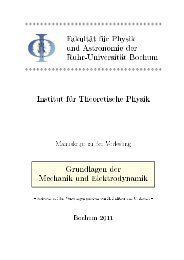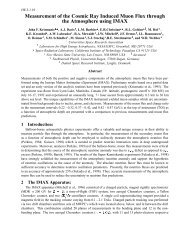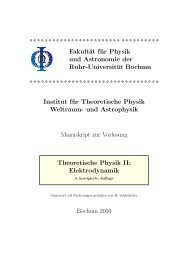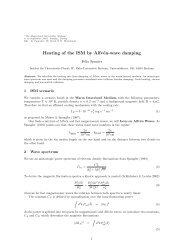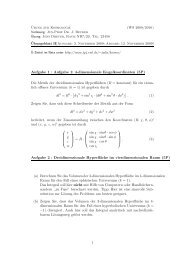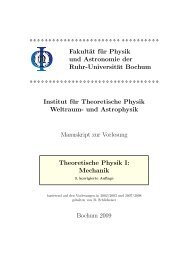pdf here - Theoretische Physik IV - Ruhr-Universität Bochum
pdf here - Theoretische Physik IV - Ruhr-Universität Bochum
pdf here - Theoretische Physik IV - Ruhr-Universität Bochum
You also want an ePaper? Increase the reach of your titles
YUMPU automatically turns print PDFs into web optimized ePapers that Google loves.
Nonlinear excitations in electron-positron-ion plasmas in<br />
accretion disks of active galactic nuclei<br />
W. M. Moslem 1 , I. Kourakis 2 , P. K. Shukla 3 , and R. Schlickeiser 4<br />
Institut für <strong>Theoretische</strong> <strong>Physik</strong> <strong>IV</strong>,<br />
Fakultät für <strong>Physik</strong> und Astronomie,<br />
<strong>Ruhr</strong>-Universität <strong>Bochum</strong>, D-44780 <strong>Bochum</strong>, Germany<br />
(Received July 12, 2007)<br />
1
Abstract<br />
The propagation of acoustic nonlinear excitations in an electron-positron-ion (e-p-i) plasma composed<br />
of warm electrons and positrons, as well as hot ions, has been investigated, by adopting a<br />
two-dimensional cylindrical geometry. The electrons and positrons are modelled by hydrodynamic<br />
‡uid equations, while the ions are assumed to follow a temperature-parametrized Boltzmann distribution<br />
(the …xed ion model is recovered in the appropriate limit). This situation applies in the<br />
accretion disk near a black hole in active galactic nuclei (AGN), w<strong>here</strong> the ion temperature may<br />
be as high as 3<br />
300 times that of the electrons. Using a reductive perturbation technique, a<br />
cylindrical Kadomtsev-Petviashvili (CKP) equation is derived and its exact soliton solutions are<br />
presented. Furthermore, real situations in which the strength of the nonlinearity may be weak is<br />
considered, so that higher-order nonlinearity plays an important role. Accordingly, an extended<br />
cylindrical Kadomtsev-Petviashvili equation (ECKP) is derived, which admits both soliton and<br />
double layer solutions. The characteristics of the nonlinear excitations obtained are investigated<br />
in detail.<br />
— — — — — — — — — — —<br />
PACS numbers: 50.27.Ep, 52.35.Fp., 52.35.Mw, 52.35.Sb<br />
1 Also at: Department of Physics, Faculty of Education-Port Said, Suez Canal University, Egypt.<br />
Email: wmmoslem@hotmail.com (wmm@tp4.rub.de)<br />
2 Email: ioannis@tp4.rub.de<br />
3 Also at: School of Physics, University of Kwazulu-Durban, Durban 4000, South Africa; Department<br />
of Physics, Umeå University, SE-90187 Umeå, Sweden; Max-Planck Institut für Extraterrestrische<br />
<strong>Physik</strong>, D-85741 Garching, Germany; GoLP/Instituto Superior Técnico, 1049-001 Lisbon,<br />
Portugal; CCLRC Centre for Fundamental Physics, Rutherford Appleton Laboratory, Chilton,<br />
Didcot, Oxon 0X11 0QX, UK; SUPA Department of Physics, University of Strathclyde, Glasgow<br />
G 40NG, UK. Email: ps@tp4.rub.de<br />
4 Email: rsch@tp4.rub.de<br />
2
I. INTRODUCTION<br />
In contrast to ordinary plasmas consisting of electrons and positive ions, linear and nonlinear<br />
waves in electron-positron (e-p) plasmas behave di¤erently [1]. Such plasmas are<br />
believed to exist in the early universe [2], in active galactic nuclei [3], in pulsar magnetosp<strong>here</strong>s<br />
[4], in solar atmosp<strong>here</strong> [5], at the center of our own galaxy [6], and are also of<br />
relevance in inertial con…nement fusion schemes using ultraintense lasers [7]. A number of pioneering<br />
experiments [8] have been carried out to produce positrons in laboratory. Recently,<br />
Helander and Ward [9] have discussed the possibility of e-p production in large tokamaks<br />
due to collisions between multi-MeV runaway electrons and thermal particles.<br />
An electron-positron plasma usually behaves as a fully ionized gas consisting of electrons<br />
and positrons, as seen in the solar atmosp<strong>here</strong> [5]. Since many of the astrophysical plasmas<br />
contain ions besides the electrons and positrons, it is important to study the behavior of<br />
nonlinear wave motions in an electron-positron-ion (e-p-i) plasma. During the last three<br />
decades, e-p and e-p-i plasmas have attracted signi…cant attention among researchers [10–<br />
18]. Linear and nonlinear wave propagation in e-p and e-p-i plasmas have been studied by<br />
using di¤erent models. For example, Popel et al. [13] investigated ion-acoustic solitons in<br />
three-component plasmas, whose constituents are electrons, positrons and singly charged<br />
ions. It is found that the presence of the positron component can result in the reduction<br />
of the ion-acoustic amplitude. Nejoh [15] studied the e¤ect of the ion temperature on large<br />
amplitude ion-acoustic waves in an e-p-i plasma. He found that the ion temperature increases<br />
the maximum Mach number and decreases the amplitude of the ion-acoustic waves.<br />
Also, the region of the existence of the ion-acoustic waves spreads as the ion temperature<br />
decreases. Shukla and Shukla [17] have shown that magnetic …eld aligned equilibrium relativistic<br />
plasmas ‡ows can excite electromagnetic ‡uctuations in a magnetized e-p plasma.<br />
The dispersion relation admits purely growing instabilities of electromagnetic perturbations<br />
across the ambient magnetic …eld direction.<br />
Relying on physical principles, the ionic temperature has tacitly been assumed to be<br />
lower than the electron and positron temperatures, and hence the ions were treated as a<br />
‡uid, while the electrons and positrons were treated either as a ‡uid or as Boltzmannean.<br />
This assumption is valid for many astrophysical situations and laboratory experiments.<br />
However, it is reported that the inner region of the accretion disk in active galactic nuclei<br />
3
[19] bear electron temperatures of 10 9 K and ion temperatures 3 300 times hotter than that<br />
of the electrons. Our purpose in this paper is to investigate the behavior of the electrostatic<br />
waves in the inner region of the accretion disk by adopting an appropriate model. We<br />
consider a three-component e-p-i plasma in which the electrons and positrons are modeled<br />
by hydrodynamic (plasma-‡uid) equations and the ions are assumed to follow a Boltzmann<br />
distribution. We shall examine the e¤ects of the electron-to-ion temperature ratio, the<br />
positron-to-electron density ratio and the soliton propagation speed on the properties of<br />
nonlinear electrostatic excitations (solitons and double layers).<br />
In Section II, we present the governing equations for the electrostatic waves in our e-p-i<br />
plasma. In Sec. III, the reductive perturbation method is employed to derive a cylindrical<br />
Kadomtsev-Petviashvili equation (CKP). In Sec. <strong>IV</strong>, we obtain an appropriate equation<br />
which describes the evolution of the nonlinear ion-acoustic waves, including higher-order<br />
nonlinearity. The possibility of propagating electrostatic solitons and double layers is discussed<br />
in Sec. V. Finally, our results are summarized in Sec. VI.<br />
II.<br />
BASIC EQUATIONS<br />
We consider a collisionless, unmagnetized three-component plasma consisting of the electrons,<br />
positrons and singly charged positive ions. The nonlinear propagation of electrostatic<br />
waves in a two dimensional (2D) cylindrical geometry is governed by the electron/positron<br />
(denoted by the index e/p, respectively) continuity equation(s)<br />
@n e;p<br />
@t<br />
+ 1 r<br />
@<br />
@r (rn e;pu e;p ) + 1 @<br />
r @ (n e;pv e;p ) = 0; (1)<br />
and the e/p momentum equation(s),<br />
@u e;p<br />
@t<br />
+ u e;p<br />
@u e;p<br />
@r<br />
+ v e;p<br />
r<br />
@u e;p<br />
@<br />
v 2 e;p<br />
r<br />
+ 2 @n e;p<br />
e;p<br />
@r<br />
+ q @'<br />
e;p<br />
@r<br />
= 0; (2)<br />
and<br />
@v e;p<br />
@t<br />
+ u e;p<br />
@v e;p<br />
@r<br />
+ v e;p<br />
r<br />
@v e;p<br />
@<br />
+ u e;pv e;p<br />
r<br />
+ 2 e;p<br />
r<br />
@n e;p<br />
@r<br />
+ q e;p<br />
r<br />
@'<br />
@ = 0 : (3)<br />
Equations (1)-(3) are closed with the help of the Poisson equation,<br />
<br />
1 @<br />
r @' <br />
+ 1 @ 2 '<br />
r @r @r r 2 @ + X q 2 e;p n e;p + n i = 0: (4)<br />
e;p<br />
4
We shall assume that the ions are Boltzmann distributed and their ion number density is<br />
n i = exp( i '): (5)<br />
This choice, though seemingly counter-intuitive, is motivated by accretion disk plasma gas<br />
models [19], w<strong>here</strong> the ions are reported to be up to 300 times hotter than the electrons (a<br />
more conventional …xed-ion hypothesis may also be adopted, upon simply setting i = 0,<br />
viz. n i = constant, in the forthcoming algebra). In (1)-(5), r and are the radial and<br />
polar angle coordinates, n e(p) and n i are the number densities of electrons (positrons) and<br />
ions, respectively, u e(p) and v e(p) are the electron (positron) velocities in the r and directions,<br />
respectively and ' is the electrostatic potential. The time and space variables,<br />
t and r; are normalized by the electron plasma period ! 1<br />
pe<br />
[= (4e 2 n e0 =m) 1=2 ] and the<br />
electron Debye radius De [= (T e =4e 2 n e0 ) 1=2 ], respectively. The densities n e=p=i , velocities<br />
(u e=p ; v e=p ) and electrostatic potential ' are normalized by the unperturbed equilibrium number<br />
electron density n e0 , the electron thermal speed C de [= (T e =m) 1=2 ] and T e =e, respectively<br />
(Boltzmann’s constant is omitted everyw<strong>here</strong>). We have denoted e = 1 for the electrons,<br />
p = T p =T e for the positrons and i = T e =T i for the positive ions. Finally, we have de…ned<br />
the dimensionless parameters q e =<br />
The quasi-neutrality condition at equilibrium reads<br />
1 (for the electrons) and q p = 1 (for the positrons).<br />
+ = 1 ; (6)<br />
w<strong>here</strong> = n i0 =n e0 and = n p0 =n e0 denote the ion-to-electron and positron-to-electron<br />
unperturbed density ratio(s).<br />
III.<br />
QUASI-CONCENTRIC NONLINEAR WAVE PROPAGATION - DER<strong>IV</strong>A-<br />
TION OF THE CYLINDRICAL KADOMTSEV-PETVIASHVILI EQUATION<br />
In view of investigating the nonlinear propagation of the electrostatic waves, we shall<br />
employ a reductive perturbation technique [20, 21]. We anticipate excitations with nearly<br />
cylindrical symmetry, so the angle subtended by the wavefront in the nearly-concentric case<br />
may be assumed to be small. The independent variables can be stretched as<br />
= " 1=2 (r t); = " 1=2 ; and = " 3=2 t; (7)<br />
5
w<strong>here</strong> " is a small parameter and is the wave propagation speed, to be determined latter.<br />
The dependent variables are expanded as<br />
n e;p = + "n (1)<br />
e;p + " 2 n (2)<br />
e;p + " 3 n (3)<br />
e;p + ::::::; (8)<br />
u e;p = "u (1)<br />
e;p + " 2 u (2)<br />
e;p + " 3 u (3)<br />
e;p + ::::::::::; (9)<br />
v e;p = " 3=2 v (1)<br />
e;p + " 5=2 v (2)<br />
e;p + " 7=2 v (3)<br />
e;p + :::::; (10)<br />
' = "' (1) + " 2 ' (2) + " 3 ' (3) + :::::::::; (11)<br />
w<strong>here</strong> = 1 for the electrons and = for the positrons.<br />
The perturbation method to be adopted <strong>here</strong> consists in substituting Eqs. (7)-(11) into<br />
the model Eqs. (1)-(5), and isolating, and then solving, distinct orders in ". The lowest<br />
order in " gives<br />
n (1)<br />
e;p = q e;p<br />
S e;p<br />
' (1) ; u (1)<br />
e;p = q e;p<br />
S e;p<br />
' (1) ;<br />
@v (1)<br />
e;p<br />
@<br />
= q e;p<br />
S e;p<br />
@' (1)<br />
@ : (12)<br />
w<strong>here</strong> S e;p = 2 2 e;p , i.e., S e = 2 2 and S p = 2 2 p . The sign of the latter<br />
may be positive or negative, depending on the values of the plasma parameters<br />
; e;p and : Note that the (leading order) perturbation of the electric potential<br />
determines the corresponding variation of the electron and positron density and<br />
velocity. For instance, physically speaking, an electron density compression may<br />
usually be expected w<strong>here</strong> a positron rarefaction is found, and vice versa; note,<br />
however, that this is not always the case, since n (1)<br />
e =<br />
1<br />
S e<br />
' (1) and n (1)<br />
p = <br />
S p<br />
' (1)<br />
bear the same sign between p 2 and p 2 p (opposite signs elsew<strong>here</strong>).<br />
The Poisson equation provides the compatibility condition<br />
The next-order in the perturbation yields<br />
1<br />
2 2 + <br />
2 2 p = i ; (13)<br />
@n(1) e;p<br />
@<br />
2 @n(2) e;p<br />
@<br />
+ @u(2) e;p<br />
@<br />
+ @ @ n(1)<br />
e;pu (1)<br />
e;p<br />
<br />
+<br />
<br />
u(1) e;p + <br />
@v (1)<br />
e;p<br />
@<br />
= 0; (14)<br />
and<br />
@u (1)<br />
e;p<br />
@<br />
@ 2 ' (1)<br />
@ 2<br />
@u(2) e;p<br />
@<br />
+ X e;p<br />
+ u (1) @u (1)<br />
e;p<br />
e;p<br />
@<br />
+ 2 e;p<br />
@n (2)<br />
e;p<br />
@<br />
+ q e;p<br />
@' (2)<br />
@<br />
= 0; (15)<br />
q e;p n (2)<br />
e;p i ' (2) + 1 2 2 i ' (1)2 = 0 : (16)<br />
6
Eliminating the second-order perturbed quantities and making use of the …rst-order results,<br />
we obtain a nonlinear partial-derivative equation (PDE) in the form of the cylindrical<br />
Kadomtsev-Petviashvili (CKP) equation<br />
<br />
@ @'<br />
(1)<br />
(1) @'(1)<br />
+ A' + B @3 ' (1)<br />
+ 1 <br />
@ @ @ @ 3 2 '(1) + 1 @ 2 ' (1)<br />
= 0 : (17)<br />
2 2 @ 2<br />
The nonlinearity and di¤usion coe¢ cients, A and B respectively, read<br />
A = 3 <br />
1 1<br />
+ <br />
2 2 2 2<br />
i 2 ; (18)<br />
2 p <br />
B = (2 2) 2<br />
2<br />
+ (2 2 p ) 2<br />
2<br />
: (19)<br />
We note that B is usually greater than zero, while the sign of A depends on speci…c parameter<br />
values, as we shall see below. Note that, combining with (13), the dependence of A and B<br />
on p is eliminated. So, A and B depend on ; i and only.<br />
To obtain an exact solitary wave solution of Eq. (17), we shall use the following substitution<br />
[21]<br />
= <br />
<br />
2 2 ; and ' (1) = ' (1) (; ); (20)<br />
into Eq. (17). We thus obtain the standard Korteweg-de Vries (KdV) equation<br />
@' (1)<br />
@<br />
(1) @'(1)<br />
+ A' + B @3 ' (1)<br />
= 0: (21)<br />
@ @ 3<br />
In order to obtain a steady-state travelling-wave solution of Eq.<br />
transformation<br />
(21), we introduce the<br />
= U 0 ; (22)<br />
w<strong>here</strong> U 0 is a real constant representing the speed of the moving wavefront. Assuming the<br />
boundary conditions ' ! 0 and d'=d ! 0 at jj ! 1, we obtain a solitary wave solution<br />
(KdV soliton)<br />
' (1) = ' 0 sech 2 <br />
U0 <br />
W<br />
<br />
; (23)<br />
w<strong>here</strong> ' 0 = 3U 0 =A is the maximum (potential perturbation) amplitude and W = p 4B=U 0<br />
measures the spatial extension (width) of the localized pulse. We note that ' 0 W 2 =<br />
12B=A = constant (for given ); in agreement with the standard KdV result [22]. However,<br />
the dependence of ' 0 and W on is more perplex, as we shall see below. Combining Eq.<br />
7
(20) with (23), we obtain the bell-shaped potential excitation<br />
!<br />
' (1) = ' 0 sech 2 (U 0 + 2 2 )<br />
W<br />
: (24)<br />
It is clear that the propagation speed of the solitary wave is angle dependent, i.e., the<br />
cylindrical wave will slightly deform as time or propagation polar angle progress.<br />
Note that the sign of the nonlinear coe¢ cient A a¤ects the sign of ' 0 , which in turn<br />
determines the sign of the potential perturbation ' (1) ; t<strong>here</strong>fore, both positive and negative<br />
pulses may possibly be obtained, for di¤erent parameter values, respectively, representing a<br />
potential hump or a dip (an electrostatic potential hole). Furthermore, note that the soliton<br />
amplitude ' 0 is proportional to the soliton speed U 0 and inversely proportional to the soliton<br />
width W , hence faster KdV soliton solutions will be taller and narrower, while slower ones<br />
will be shorter and wider. The qualitative features of the KdV solitons are thus recovered<br />
[22].<br />
Relying on the above …ndings, we shall now investigate the e¤ect of relevant physical<br />
quantities, namely the electron-to-ion temperature ratio ( i ), the positron-to-electron density<br />
ratio () and the soliton propagation speed () on the properties of nonlinear electrostatic<br />
excitations in e-p-i plasmas. See that p is prescribed from (13), once the remaining<br />
parameters are prescribed.<br />
Figure 1a depicts the soliton amplitude as a function of the propagation speed<br />
. The pulse will have a bell-shaped form for a low propagation speed, representing<br />
a localized potential increase (a positive excitation, viz. ' 0 > 0, i.e., a<br />
hump). An inverted bell-shaped form (a negative perturbation, viz. ' 0 < 0, i.e.<br />
an electrostatic hole, a potential void) occurs for higher values of . The positive<br />
(pulse) soliton pro…le becomes less sharp by increasing up to p 2 1:414.<br />
In fact, A has a pole at = p 2; nonlinearity becomes in…nitely high in the<br />
neighborhood, so no dispersion-nonlinearity-managed excitations are expected<br />
to occur in the vicinity of this value. On the other hand, the negative (pulse)<br />
excitation pro…le becomes sharper (higher) by increasing . Reducing the ionic<br />
temperature, i.e. increasing i , leads to a decreases (increases) in the amplitude<br />
of positive (negative) solitons. Furthermore, increasing the value of (i.e. increasing<br />
the positron concentration, or decreasing the ions) makes the soliton<br />
pro…le sharper, i.e., increases the value of ' 0 . Figure 1b depicts the e¤ect of the<br />
8
propagation speed and the positron-to-electron density ratio on the soliton<br />
width, as obtained from the relation W = p 4B=U 0 . It is clear that the positive<br />
(pulse) soliton width decreases with , while the opposite happens to negative<br />
(hole) solitons. Furthermore, the soliton width becomes wider by increasing the<br />
value of . The electrostatic potential pulse excitations ' (1) are depicted in Fig.<br />
2, against the radial coordinate r and the polar angle : It is observed that the<br />
propagation of both positive and negative soliton pulses in the radial direction is<br />
slightly distorted and accelerated due to (weak) angular, i.e., non-gyrotropic effects.<br />
Note that the real value of the electrostatic potential is (T e =e)' (1) 86:2' (1)<br />
(in KVolts), for an electron temperature of 10 9 K [19].<br />
<strong>IV</strong>.<br />
EXCITATIONS AT CRITICALLY NONLINEAR PLASMA COMPOSITIONS<br />
Summarizing the above analysis, we have developed a theory for nonlinear excitations in<br />
e-p-i plasmas, in fact reducing the system of plasma-‡uid equations to a CKP equation. An<br />
appropriate travelling-wave ansatz has enabled us to reduce the CKP equation further to a<br />
KdV equation, which features a nonlinearity coe¢ cient A given by Eq. (18). The solutions<br />
thus obtained are sustained by a balance between dispersion (expressed by the coe¢ cient<br />
B) and nonlinearity (expressed by A). An important question arises <strong>here</strong> regarding the<br />
strength of the nonlinearity. Speci…cally, one may wonder whether the coe¢ cient A may<br />
acquire small values, and what happens then. Interestingly, this appears to be the case in<br />
accretion disks. For instance, adopting values from Ref. [19] for i = 1=3; = 0:1; and<br />
= 2:38 we obtain A = 0:1. T<strong>here</strong>fore, we may anticipate that higher-order nonlinearity<br />
enters into play, if A is of the order of, say, ". To answer this question, one should obtain<br />
an appropriate equation which describes the evolution of the system in this case. In this<br />
section, we shall t<strong>here</strong>fore explicitly assume that A ", in order to examine the behavior<br />
of the nonlinear waves in an e-p-i plasma at critical compositions. A similar discussion has<br />
been carried out in multi-species e-i plasmas; see, e.g., in Ref. [23].<br />
Adopting a slightly di¤erent version of the reductive perturbation technique, we now<br />
introduce stretched space-time coordinates<br />
= "(r t) ; = " 1 and = " 3 t : (25)<br />
9
The dependent variables are expanded in a manner similar to Eqs. (8)-(11). Using the new<br />
stretching (25) along with Eqs. (8)-(11) into Eqs. (1)-(5) and equating the terms arising at<br />
the lowest-order in "; we obtain the same linearized expressions (12) and the compatibility<br />
relation (13).<br />
The next-order in " gives<br />
n (2)<br />
e;p = 32 <br />
2S 3 e;p<br />
u (2)<br />
e;p = 1<br />
2S 3 e;p<br />
' (1)2 + q e;p<br />
S e;p<br />
' (2) ; (26)<br />
3 + 4 e;p ' (1)2 + q e;p<br />
S e;p<br />
' (2) : (27)<br />
The next higher order, O(" 3 ) of the Poisson equation, upon using the …rst- and secondorder<br />
solutions, leads to the extended CKP (ECKP) equation [24]<br />
<br />
@ @'<br />
(1)<br />
(1) @'(1) (1)2 @'(1)<br />
+ A' + C' + B @3 ' (1)<br />
+ 1 <br />
@ @ @<br />
@ @ 3 2 '(1) + 1 @ 2 ' (1)<br />
= 0; (28)<br />
2 2 @ 2<br />
w<strong>here</strong> A and B are given in (18), (19), and<br />
C = 3 5 2 + 8<br />
4 2 2 + 52 + 8 p 1<br />
2 2 p 2 3 i : (29)<br />
By applying the ansatz (20) in the evolution Eq. (28), we obtain the extended KdV (EKdV)<br />
equation<br />
@' (1)<br />
@<br />
+ A 2<br />
@' (1)2<br />
@<br />
+ C 3<br />
@' (1)3<br />
@<br />
+ B @3 ' (1)<br />
@ 3 = 0 : (30)<br />
V. SOLUTION OF THE EKDV EQUATION VIA A PSEUDO-POTENTIAL<br />
METHOD<br />
The EKdV equation (30) may be solved by quadrature. Using the travelling-wave transformation<br />
(22), and integrating, by using vanishing boundary conditions at in…nity, we<br />
obtain<br />
<br />
1 d'<br />
(1) 2<br />
+ V ' (1) = 0 : (31)<br />
2 d<br />
This relation suggests that the evolution of a solitary excitation is analogous to the problem<br />
of motion of a unit mass in a (Sagdeev-like [25]) pseudo-potential, given by<br />
V (' (1) ) = U 0<br />
2B '(1)2 + A<br />
6B '(1)3 +<br />
C<br />
12B '(1)4 : (32)<br />
In the following, we shall investigate the form and properties of the solutions related to the<br />
above pseudo-energy-balance equation.<br />
10
A. Solitary wave solution<br />
The solitary wave solution(s) of Eq.(31) may be cast in the form<br />
w<strong>here</strong><br />
d'<br />
(1) 2<br />
=<br />
C <br />
d 6B '(1)2 ' (1)2 + 2A <br />
6U 0<br />
C '(1) ;<br />
C<br />
= C<br />
6B '(1)2 (' (1) ' 1 )(' (1) ' 2 ); (33)<br />
' 1 =<br />
1 C<br />
<br />
A<br />
p <br />
; ' 2 = 1 <br />
A + p <br />
; and = A 2 + 6U 0 C: (34)<br />
C<br />
We are looking for stationary soliton solutions, whose pro…le vanishes in the unperturbed<br />
region. For this reason, we have used ' ! 0 and d'=d ! 0 at jj ! 1: After integrating<br />
Eq. (33) we then obtain positive and negative soliton solutions [26], respectively<br />
' (1)<br />
+ =<br />
' (1) =<br />
(6U 0 =C)<br />
; (35)<br />
' 1 sinh 2 1<br />
2p<br />
U0 =B ' 2 cosh 2 1<br />
2p<br />
U0 =B<br />
' 2 sinh 2 <br />
1<br />
2p<br />
U0 =B<br />
(6U 0 =C)<br />
<br />
' 1 cosh 2 <br />
1<br />
2p<br />
U0 =B<br />
: (36)<br />
To examine the soliton propagation in our e-p-i plasma, A must be in the order of " and<br />
should be positive. The range of the propagation speed (), which gives small A " and<br />
positive ; is depicted in Fig. 3(a, b) - 5(a, b) for di¤erent values of and i . It is seen<br />
that for small = 0:1, the range of is narrow for both low and high i . Increasing to<br />
0:5, one encounters only supersonic solitons. For = 0:9 neither subsonic nor supersonic<br />
solitons can propagate.<br />
In Fig.<br />
6, we have numerically analyzed the Sagdeev potential (32) and investigated<br />
how the propagation speed (), the electron-to-ion temperature ratio ( i ) and the positronto-electron<br />
density ratio () change the pro…le of the potential well. It turns out that an<br />
increase of the propagation speed (the electron-to-ion temperature ratio i and positron-toelectron<br />
density ratio ) leads to an increase (a decrease) of the potential depth, but decrease<br />
(increase) of the potential amplitude. Figure 7 shows the dependence of the compressive<br />
and rarefactive solitary pulse on the propagation speed (), the electron-to-ion temperature<br />
ratio ( i ) and the positron-to-electron density ratio (). It is obvious that faster positive<br />
11
soliton has lower amplitude and narrower width. Increasing leads to an increase of both<br />
the soliton amplitude and the width. However, the amplitude (width) increases (decreases)<br />
with increasing i .<br />
B. Double layer solution<br />
For the double layer solution, the Sagdeev potential V (' (1) ) should be negative between<br />
' (1) = 0 and ' m , w<strong>here</strong> ' m is some double root of the potential. T<strong>here</strong>fore, for the formation<br />
of double layers, V (' (1) ) must satisfy the following conditions<br />
V (' (1) ) = 0 at ' (1) = 0 and ' (1) = ' m ; (37)<br />
V 0 (' (1) ) = 0 at ' (1) = 0 and ' (1) = ' m ; (38)<br />
V 00 (' (1) ) < 0 at ' (1) = 0 and ' (1) = ' m : (39)<br />
Applying the boundary condition (37) and (38) into Eq. (31), we obtain the conditions for<br />
existence of double layers<br />
U 0 =<br />
A2<br />
6C ; and ' m = A C : (40)<br />
Notice that these conditions are tantamount to = 0 [cf. (34) above]. See also that the<br />
double layer propagation speed (correction) U 0 is exactly prescribed by (40). Substituting<br />
U 0 and A from Eq. (40) into Eq. (31), we have<br />
V (' (1) ) = C'(1)2<br />
12B (' m ' (1) ) 2 : (41)<br />
Here, C < 0 has to be ful…lled, in order for V < 0, and thus reality to be ensured cf. (32).<br />
Notice that, from (40), the double root <strong>here</strong> has the same sign as A: However, negative<br />
values of both A and C are partially excluded, as we see in Figs. 2a,b to 4a,c. Thus, double<br />
layers will only exist for A > 0, and should correspond to positive potential excitations.<br />
This is indeed con…rmed below.<br />
The solution of Eq. (31), with Eq. (41), is then<br />
' (1) = ' m<br />
2<br />
"<br />
1=2 C<br />
1 tanh ' m ( U 0 )!#<br />
: (42)<br />
24B<br />
12
The DL solution (42) corresponds to a localized transition among two …nite potential regions.<br />
Combining Eq. (20) with (42), we obtain<br />
' (1) = ' m<br />
2<br />
The width of the double layer is<br />
"<br />
1=2 C<br />
1 tanh ' m ( (U 0 + ))!#<br />
<br />
24B<br />
2 2 : (43)<br />
W DL =<br />
p<br />
24B=C<br />
: (44)<br />
jA=Cj<br />
As we saw above, B is always positive, the existence of double layer requires C < 0. It is<br />
also noted from Eq. (40) that the nature of the double layer depends on the sign of A; i.e.<br />
for A > 0 a positive double layer exists (viz ' m > 0; see (40)), w<strong>here</strong>as for A < 0 we would<br />
have a negative double layer (' m < 0). The numerical analysis in Figs. 2a and 2c, however,<br />
shows that for high values the dominant situation corresponds to C > 0 and A "; so<br />
the double layers cannot exist. However, for small ; double layers may occur, since C < 0<br />
and A ": Furthermore, it is seen that for small ; the nonlinear coe¢ cient A has positive<br />
value and t<strong>here</strong>fore only positive double layers can exist.<br />
Equation (41) describes the double layer Sagdeev potential, which has a well-know pro…le<br />
[27]. This pro…le may change due to vary of physical parameters. We have numerically<br />
investigated the e¤ects of the propagation speed (), the electron-to-ion temperature<br />
ratio ( i ) and the positron-to-electron density ratio () on the behavior of<br />
the Sagdeev pseudo-potential (41); see Figure 8. We recall that the position of<br />
the double root determines the amplitude of the excitation, while the potential<br />
depth at the minimum <strong>here</strong> determines the slope (and width) of the excitation;<br />
cf. Figs. 8 and 9. It is found (Figs. 8a and 9a) that increasing the velocity<br />
leads to a slightly smaller (shorter, in amplitude) excitation. A smaller DL<br />
amplitude is also witnessed by increasing the positron concentration, i.e.<br />
higher values (see Figs. 8b and 9b). Finally, an increase in the ionic temperature<br />
(i.e., smaller values of i ) shrinks the DL amplitude; in the limit i ! 0<br />
(…xed ion limit), no DL excitations are expected to occur.<br />
for<br />
The dependence of<br />
double layer characteristics on the propagation speed (), the electron-to-ion temperature<br />
ratio ( i ) and the positron-to-electron density ratio () is displayed in Fig. 9. It is seen<br />
that the amplitude and the width of the double layers decrease at high propagation speed.<br />
13
Increasing and i would lead to a decrease of the amplitude but the width would increase<br />
slightly. Figure 10 represents the electrostatic potential, as expressed by Eqs.<br />
(35), (36) and (42), depicted in three-dimensional plots versus the radial coordinate<br />
r and the polar angle :It is clear that the propagation of both positive<br />
and negative soliton pulses as well as the shock waves being slightly distorted<br />
with polar angle.<br />
VI.<br />
SUMMARY<br />
In this paper, we have studied the nonlinear propagation of electron-acoustic waves in<br />
an electron-positron-ion plasma .<br />
A background of thermalized ions was considered as<br />
a hypothesis that occurs in accretion disks of AGN. By adopting a cylindrical geometry,<br />
we have derived a cylindrical Kadomtsev-Petviashvili equation, which yields exact soliton<br />
solutions in the form of positive or negative potential pulse excitations.<br />
Furthermore, we have also considered situations in which the strength of the nonlinearity<br />
is weak, so that higher-order nonlinearity may play an important role. We have derived an<br />
extended cylindrical Kadomtsev-Petviashvili (ECKP) equation, modelling the potential evolution<br />
in this case. Exact solutions of ECKP equation were derived, in the form of localized<br />
pulses (which were compared to the CKP pulses obtained previously) and double layers, i.e.,<br />
propagating localized transition forms (double layers) among regions of constant potential.<br />
A set of exact expressions was presented for these localized potential perturbations, and<br />
their characteristics were investigated.<br />
The nonlinear structures derived in this study owe their existence to a balance among the<br />
dispersion and nonlinearity, and were obtained in a 2D cylindrical geometry (in radial and<br />
angular polar coordinates), thus representing structures propagating in the radial direction<br />
while being slightly distorted and accelerated due to angular, i.e., (weak) non-gyrotropic<br />
e¤ects. Anticipating a more general theoretical scope, it may be pointed out that, from a<br />
qualitative point of view, the various scaling assumptions employed <strong>here</strong> amount to the form<br />
' (1) = ' (1) (R) for the localized excitation (solitons, double layers), w<strong>here</strong> R is the moving<br />
frame de…ned by:<br />
R = " 1=2 r<br />
+ "U 0 + <br />
2 2 t : (45)<br />
Here, is the (main radial) propagation speed, corrected by U 0 , while an angular dependence<br />
14
of the velocity is provided by the last term. The solitary potential excitations thus su¤er<br />
a velocity modi…cation due to the deviation (<strong>here</strong> assumed weak) from the radial direction.<br />
Thus, these results may be interesting, since they refer to the existence of localized excitations<br />
in cylindrical geometries, so their generic characteristics may be traced in di¤erent<br />
nonlinear dispersive systems.<br />
Acknowledgments<br />
The authors thank the referee for his/her valuable comments. W.M.M. thanks the<br />
Alexander von Humboldt-Stiftung (Bonn, Germany) for …nancial support. I.K. acknowledges<br />
support from the German Research Society (Deutsche Forschungsgemeinschaft, DFG)<br />
under the Emmy-Noether Programme (grant SH 93/3-1).<br />
15
[1] F. B. Rizzato, J. Plasma Phys. 40, 289 (1988); L. Sten‡o, P. K. Shukla and M. Y. Yu,<br />
Astrophys. Space Sci. 177, 303 (1985); R. T. Gangadhara, V, Krishan and P. K. Shukla,<br />
Mon. Not. R. Astron. Soc. 262, 151 (1993).<br />
[2] W. Misner, K. S. Thorne and J. A. Wheeler, Gravitation (Freeman, San Francisco, 1973), p.<br />
763.<br />
[3] H. R. Miller and P. J. Witta, Active Galactic Nuclei (Springer-Verlag, Berlin, 1987), p. 202.<br />
[4] V. L. Ginzburg, Sov. Phys. Usp. 14, 83 (1971); P. A. Sturrock, Astrophys. J. 164, 529 (1971);<br />
M. A. Ruderman and P. G. Sutherland, Astrophys. J. 196, 51 (1975).<br />
[5] E. Tandberg-Hansen and A. G. Emslie, The Physics of Solar Flares (Cambridge University<br />
Press, Cambridge, 1988), p. 124.<br />
[6] M. L. Burns, in Positron-Electron Pairs in Astrophysics, edited by M. L. Burns, A. K. Harding<br />
and R. Ramaty (American Institute of Physics, New York, 1983).<br />
[7] E. P. Liang, S. C. Wilks and M. Tabak, Phys. Rev. Lett. 81, 4887 (1998); C. Gahn, G. D.<br />
Tsakiris, G. Prerzler et al., Appl. Phys. Lett. 77, 2662 (2000).<br />
[8] C. M. Surko, M. Leventhal and A. Passner, Phys. Rev. Lett. 62, 901 (1989); C. M. Surko and<br />
T. J. Murphy, Phys. Fluids A 2, 1372 (1990); R. G. Greaves, M. D. Tinkle and C. M. Surko,<br />
Phys. Plasmas 1, 1439 (1994); J. Zhao, J. I. Sakai and K. Nishikawa, Phys. Plasmas 3, 844<br />
(1996).<br />
[9] P. Helander and D. J. Ward, Phys. Rev. Lett. 90, 135004 (2003).<br />
[10] V. Tystovich and C. B. Wharton, Comments Plasma Phys. Controlled Fusion 4, 91 (1978).<br />
[11] R. Bharuthram, Astrophys. Space Sci. 189, 213 (1992).<br />
[12] F. Verheest, M. A. Hellberg, G. J. Gray and R. L. Mace, Astrophys. Space Sci. 239, 125<br />
(1995); I. Kourakis, F. Verheest and N. Cramer, Physics of Plasmas, 14, 022306 (2007).<br />
[13] S. I. Popel, S. V. Vladimirov and P. K. Shukla, Phys. Plasmas 2, 716 (1995).<br />
[14] M. Y. Yu, P. K. Shukla and L. Sten‡o, APJ Lett. 309, L63 (1986).<br />
[15] Y. N. Nejoh, Phys. Plasmas 3, 1447 (1996).<br />
[16] A. Mushtaq and H. A. Shah, Phys. Plasmas 12, 072306 (2005).<br />
[17] N. Shukla and P. K. Shukla, Phys. Lett. A 362, 221 (2007).<br />
[18] A. Esfandyari-Kalejahi, I. Kourakis and P. K. Shukla, J. Phys. A: Math. General, 39, 13817<br />
16
(2006); I. Kourakis, A. Esfandyari-Kalejahi, M. Mehdipoor and P.K. Shukla, Phy. Plasmas,<br />
13, 052117 (2006).<br />
[19] S. L. Shapiro, A. P. Lightman and D. M. Eardley, Astrophys. J. 204, 187 (1976).<br />
[20] H. Washimi and T. Taniuti, Phys. Rev. Lett. 17, 996 (1966).<br />
[21] J. Xue, Phys. Plasmas 10, 3430 (2003).<br />
[22] T. Dauxois and M. Peyrard, Physics of Solitons (Cambridge University Press, 2005), p. 32<br />
and 89.<br />
[23] F. Verheest, Waves in Dusty Space Plasmas (Kluwer Academic Publishers, Dordrecht 2000),<br />
p. 112.<br />
[24] S. Watanabe, J. Phys. Soc. Jpn 53, 950 (1984); S. K. El-Labany and A. El-Sheikh, Astrophys.<br />
Space Sci. 197, 289 (1992); W. M. Moslem, J. Plasma Phys. 61, 177 (1999).<br />
[25] R. Z. Sagdeev, Review of Plasma Physics vol 4, ed. M. A. Leontovich (Consultants Bureau,<br />
New York, 1966), p. 23.<br />
[26] M. Wadati, J. Phys. Soc. Jpn. 38, 673 (1975); H. Shamel, M. Y. Yu and P. K. Shukla, Phys.<br />
Fluids 20, 1286 (1977); P. K. Shukla and M. Y. Yu, J. Math. Phys. 19, 2506 (1978).<br />
[27] L. P. Block, Astrophys. Space Sci. 55, 59 (1978); J. S. Levine and F. W. Crawford, J. Plasma<br />
Phys. 23, 223 (1980); C. Uberoi, Introduction to Unmagnetized Plasmas (Prentice-Hall of<br />
India Private Limited, New Delhi, 1988), p. 116.<br />
17
Figure Captions<br />
Figure 1.<br />
(a) The soliton amplitude ' 0 is depicted against the propagation speed ; for i = 1=300;<br />
= 0:4 (solid curve), = 0:9 (dashed curve), and i = 1=3 and = 0:4 (dotted curve). (b)<br />
The soliton width W is depicted against for = 0:1 (solid curve), = 0:5 (dashed curve)<br />
and = 0:99 (dotted curve). Here we have used U 0 = 0:1.<br />
Figure 2.<br />
The electrostatic potential ' (1) is depicted against the radial and angular coordinates,<br />
r and ;respectively: (a) compressive solitary pulse for = 1 and (b)<br />
rarefactive solitary pulse for = 2. The other plasma parameters are i = 1=300;<br />
= 0:4; U 0 = 0:1 and t = 1:<br />
Figure 3.<br />
(a) The nonlinear coe¢ cient A, (b) the determinant , and (c) the nonlinear coe¢ cient<br />
C are depicted against the propagation speed ; for i = 1=3 (solid curve), i = 1=300<br />
(dashed curve), w<strong>here</strong> = 0:1.<br />
Figure 4.<br />
(a) The nonlinear coe¢ cient A, (b) the determinant , and (c) the nonlinear coe¢ cient<br />
C are depicted against the propagation speed ; for i = 1=3 (solid curve), i = 1=4 (dashed<br />
curve), w<strong>here</strong> = 0:5.<br />
Figure 5.<br />
(a) The nonlinear coe¢ cient A, (b) the determinant , and (c) the nonlinear coe¢ cient<br />
C are depicted against the propagation speed ; for i = 1=3 (solid curve), i = 1=300<br />
(dashed curve), w<strong>here</strong> = 0:9.<br />
Figure 6.<br />
The Sagdeev potential V (' (1) ) is depicted against the electrostatic potential ' (1) , for (a)<br />
i = 1=3; = 0:1, = 2:35 (solid curve), = 2:4 (dashed curve), (b) i = 1=3; = 2:35;<br />
= 0:1 (solid curve), = 0:11 (dashed curve), (c) = 0:5, = 3:5; i = 1=3 (solid curve)<br />
and i = 1=4 (dashed curve).<br />
18
Figure 7.<br />
The potential ' (1) is depicted against for (a) i = 1=3; = 0:1, = 2:35 (solid curve),<br />
= 2:4 (dashed curve), (b) i = 1=3; = 2:4; = 0:1 (solid curve), = 0:12 (dashed<br />
curve), (c) = 0:5, = 3; i = 1=3 (solid curve) and i = 1=4 (dashed curve).<br />
Figure 8.<br />
The pseudo-potential V (' (1) ) is depicted against the electrostatic potential ' (1) , for (a)<br />
i = 1=3; = 0:5, = 0:1 (solid curve), = 0:2 (dashed curve), (b) i = 1=3; = 0:2;<br />
= 0:3 (solid curve), = 0:4 (dashed curve), (c) = 0:5, = 0:2; i = 1=3 (solid curve)<br />
and i = 1=300 (dashed curve).<br />
Figure 9.<br />
The double layer pro…le ' (1) is depicted against for (a) i = 1=3; = 0:5, = 0:1 (solid<br />
curve) and = 0:2 (dashed curve), (b) i = 1=3; = 0:2; = 0:3 (solid curve), = 0:4<br />
(dashed curve), (c) = 0:5, = 0:2; i = 1=3 (solid curve) and i = 1=300 (dashed curve).<br />
Figure 10.<br />
The solitary pulse solutions (represented by Eqs. (35) and (36)) and the<br />
double layer pro…le (represented by Eq. (42)) are depicted against the radial and<br />
angular coordinates, r and ;respectively: (a) compressive pulse, (b) rarefactive<br />
pulse (for = 2:35; i = 1=3; = 0:1; U 0 = 0:1 and t = 1, in both plots) and (c)<br />
double layer pro…le for = 0:5; i = 1=3; = 0:5; U 0 = 0:1 and t = 1:<br />
19
Figure 1
Figure 2
Figure 3
Figure 4
Figure 5
Figure 6
Figure 7
Figure 8
Figure 9
Figure 10


